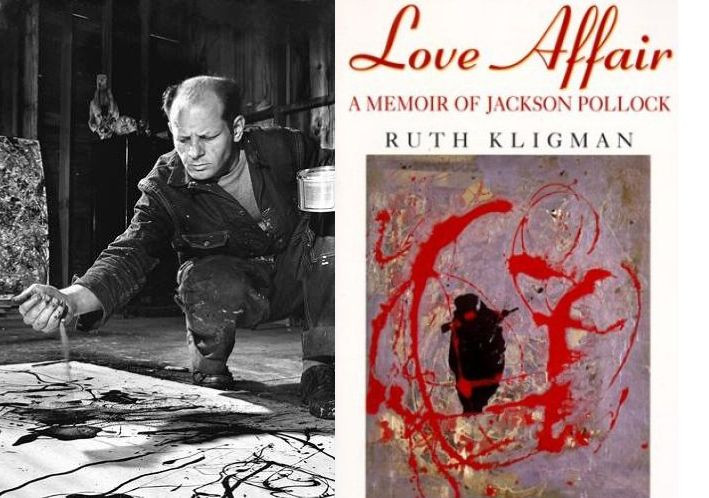Forensic Science And Art World Mysteries: The Case Of The Purported Pollock And The Telltale Polar Bear Hair

It sounds like the set-up for a cracking good mystery novel: a love affair, a long-lost painting, and a telltale polar bear hair. It’s also a real-world story of a simmering struggle between old and new guards in the art world, with expert authenticators chafing at the intrusions of forensic science into their rarefied domain.
At the center of this story is “Red, Black & Silver,” a small, unsigned painting that was supposedly that last work of famed American artist Jackson Pollock – known mostly for his characteristic drip paintings. The painting’s longtime owner was artist Ruth Kligman, Pollock’s mistress, who said the artist made it for her only weeks before he died in a car crash. But an official authentication board set up by Pollock’s widow, artist Lee Krasner, has rejected the attribution, saying that “Red, Black & Silver” does not look like one of Pollock’s works.
“I don’t think there’s a Pollock expert in the world that would look at that painting and agree it was a Pollock,” Francis O’Connor, a former Pollock authenticator said at a symposium this month, according to the New York Times.
“Red, Black & Silver” was in Kligman’s hands until she died in 2010. It was slated to go on the auction block in 2012 but was removed shortly before the hammer fell so that Kligman’s estate could keep researching the painting’s authenticity. Certifying the painting as an official Pollock would likely inflate the painting’s value at auction to well above seven figures.
Enter Nicholas Petraco, the former New York City detective hired by Kligman’s estate to scrutinize the painting with the same rigor he used to bring to crime scenes.
Forensic science is not always incontrovertible evidence, but it can build a very strong case for authenticating a masterwork or identifying a fake. An examiner can test the materials of the work – from paint pigments, to the canvas or wood it was painted on – to make sure that the age of the materials matches up with the supposed date of the work. Analysts can look for traces of old paint pigments that are no longer used (either because they were toxic, like White Lead, or made from ground-up mummified corpses – cat and human – like Mummy Brown). They can also use infrared light to look at the lower layers of the painting, down to the initial charcoal sketch. Physicists at the University of Notre Dame have also rigged up a way to blast artworks with ion beams (harmlessly) to hunt for molecular clues.
In the case of “Red, Black & Silver,” Petraco concentrated not on the paint but on the contextual evidence trapped beneath the surface: dust, fibers, hairs, and other things that might make a trail leading back to Pollock. A big break came when Petraco found a polar bear hair in the painting – not something that would turn up just anywhere. And it just so happens that Pollock’s East Hampton house had a polar bear-skin rug on the living room floor.
Other clues reinforced the story. Seeds and sand trapped in the paint matched similar grains in Pollock's house, and Petraco also matched human hair and fibers from the painting to materials found in Pollock's shoes.
Case closed? Not necessarily. O’Connor, the art expert, told the Times that while the painting might have been made at Pollock’s house, that doesn’t mean for certain that Pollock’s hand held the brush.
This also isn’t the first purported Pollock painting of questionable provenance. A former truck driver named Teri Horton bought a painting for $5 in a San Bernadino, Calif., thrift shop, only to hear from a local art teacher that it might be a Jackson Pollock.
“And that's when I said, 'Who the f--- is Jackson Pollock?'” Horton told CBS.
A documentary film crew showed Horton’s painting to several experts in the art world, including the late Thomas Hoving, former director of the Metropolitan Museum of Art. Hoving’s gut feeling was that the work was too “neat” and “compacted” to be a real Pollock.
But Horton’s forensic claim may be even stronger than Kligman’s. A forensic art expert, Paul Biro, compared a fingerprint on the back of Horton’s painting to a fingerprint on a can of blue paint in Pollock’s Long Island art studio, and another fingerprint on a verified Pollock painting hanging in the Tate Modern museum in London. They matched up. But suspicions remain -- Hoving himself wrote about some investigations that suggest the Pollock fingerprint from the paint can had been transferred to other paintings after the fact.
"I figured that the $5 picture was not a fake but a decorator’s piece," Hoving wrote. "You know, 'Gimme some big abstract -- like Pollock -- but make it with the colors of my new living room.' There are dozens [of those] around."
© Copyright IBTimes 2024. All rights reserved.




















